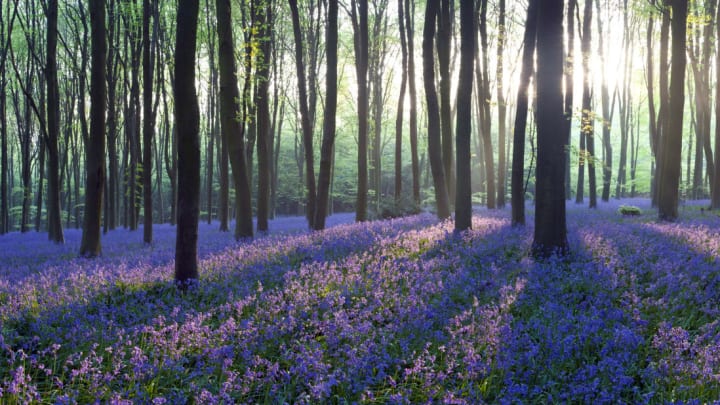Imagine if the poppy fields in The Wizard of Oz were all blue—and real. That's how Belgium's Hallerbos forest looks for a short time each spring. For roughly 10 days in April or May, innumerable bluebells blossom, covering the forest's floor in a lovely violet.
Dutch for "Halle's forest," Hallerbos is located about 30 minutes outside of Brussels. But while the forest is currently part of the Belgian state, its ownership has varied, starting with its first known owner in the 7th century. Records list it as having been part of the expansive land of the Abbey of St. Waltrudis, in Mons (about an hour south of the forest). A few centuries later, it became part of the duchy of Arenberg before passing to the French Republic after their troops invaded in 1794, then to the Netherlands in 1815, and eventually returning to the Duke of Arenberg in 1831.
Unfortunately, when World War I hit Europe, the German army felled much of the forest for wood, diminishing its original size of 1125 hectares down to 569 hectares (or roughly 1400 acres). Belgium regained control of the Hallerbos forest in 1929 and spent the next 20 years actively reforesting the land. This extensive history is what, in part, makes the forest look the way it is today—because though the trees are relatively new, the bluebells are ancient.
In fact, an abundance of bluebells is an indicator of the age of a forest. Certain types of flowers, including the small, white wood anemones and pale yellow native primroses, are very often markers of ancient woodlands—this flora grows deep underground and doesn't spread through trafficked or harvested land, meaning that that larger groves of them tend to only be found in secluded areas. And for bluebells (also called wood hyacinth or wild hyacinth), their life cycle is dependent on brisk weather and sunshine, so they sprout and bloom before the trees above them have fully budded. Then, as quickly as they came, they turn to seed and continue growing their roots deeper to survive another year.
And thus, the extraordinary sight of a blanket of bluebells scattered through the forest is best observed during the early spring. Of course, this effect makes for some absolutely gorgeous photographs, so it's no wonder that visitors flock to the woods each year. Hallerbos provides directions to the forest by both car and public transportation, as well as two different maps for walks through the growth and a bloom tracker to plan for the prettiest possible visit.
